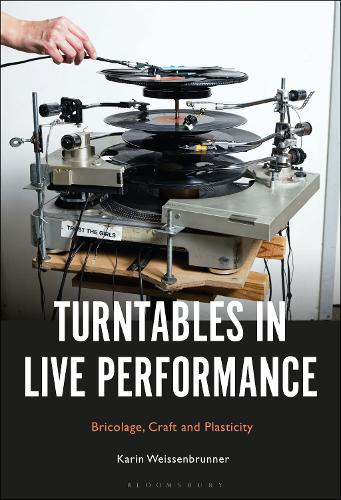
Turntables in Live Performance: Bricolage, Craft and Plasticity
(Hardback)
Publishing Details
Turntables in Live Performance: Bricolage, Craft and Plasticity
By (Author) Dr. Karin Weissenbrunner
Bloomsbury Publishing USA
Bloomsbury Publishing USA
19th March 2026
United States
Classifications
Professional and Scholarly
Non Fiction
Music recording and reproduction
Performing arts
Media studies
Physical Properties
Hardback
240
Width 152mm, Height 229mm
Description
This interdisciplinary study offers the first-ever analytical survey of experimental turntablism, highlighting the various ways in which turntables and records have been the starting point for sound experiments.
Record players and records have been the starting point for a multitude of sound experiments beginning with the use of mechanical phonographic devices and later in the appropriation of destroyed and broken media technologies and objects. Then as now, the materiality of the sound-reproduction medium has consistently guided sonic research. The record player itself forms the key concept within which each artist unfolds an intricate dialogue between mediality and materiality. Sonic and material features become intertwined in inseparable alliances, live generated and pre-recorded sounds develop dynamic relationships. Not only is the phonographic medium repurposed as an instrument, it moreover serves as a multipurpose and rich tool set for composition, improvisation and conceptualisation, in both sonic and performative dimensions.
Turntables in Live Performance explores central ideas, techniques and strategies in experimental turntable practices. The book discusses the craftsmanship of contemporary sound artists and proposes an interdisciplinary methodology for analysing the interdependencies between artist, instrument and performance context in improvised performances with live electronics. The analytical framework targets the acoustic dimension in relation to performative aspects, addressing instrumentality, mediality and corporeality. The book reveals their entanglement on a detailed level and demonstrates how this advances the phonographic medium as a resourceful tool responsible for a wealth of musical meaning on multiple levels. Its case studies represent a wide range of individual approaches, paying attention to aesthetics of destruction, imperfection, chance and spontaneity but also limitation, precision and skill. Video documentations combined with interactive graphic transcriptions support the performance analyses.
Author Bio
Karin Weissenbrunner is an independent scholar and curator based in Germany. She holds a PhD in music from City St Georges, University of London, UK. Her curatorial and artistic projects are related to various forms of art, with a focus on sound, media, materials and the environment.
